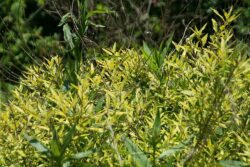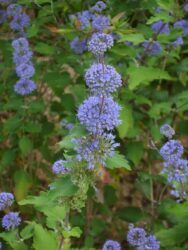In this article, we will discover how to grow the small but delightful shrub of Caryopteris in containers. Caryopteris is a flowering shrub of the Lamiaceae (the mint or sage) family, where 7 species are known to exist. It is a native of East Asia and found in China, Korea, Japan and Mongolia. It is a small bush often found growing no more than a few metres in height.

The main selling point is that it is in flower after most other shrubs have finished blooming, the leaves are not only attractive but they are aromatic as well. The leaves are heavily serrated, oval and embellished by a silver underside. The leaves look attractive but the blue/lilac blooms are the main reason why it is grown. In September or October, 10cm long terminal clusters of flowers appear that are blue or lilac and are produced on dark slender stems.
As they are small plants they make great specimen plants in containers. One problem is that in the past they had a bad reputation with cold, frosty weather, as it was believed that harsh winters will kill the plant. This is not true as even if the young shoots are killed, new stems will appear in spring.
Find out how to grow Blue Spiraea in containers in this article.
GROW CARYOPTERIS IN CONTAINERS
First, choose a container that will suit the shrub in question. No matter what you choose make sure it has plenty of drainage holes in them. They are not fussy about what kind of compost is used as long as it is well-draining. To the bottom of the container add a 2cm layer of gravel as this will aid drainage even further. On top of this add a mixture made by mixing 80% by volume of multipurpose compost with 20% by volume of manure to give an enriched growing media. Fill the container to within 5cm of the rim.
Dig a hole at the centre of the container slightly bigger than the root ball it came in the original containers. Drop the plant in so that the top of the root ball is at the same level as the top surface of the compost. Backfill with the growing media so that no vacant spots remain, using more compost if necessary. Firm the plant in and water well.
CARE INSTRUCTIONS
They are not difficult to look after at all requiring little in the way of maintenance throughout the growing season.

You will need to water frequently throughout the growing season so that a strong and extensive root system develops. It is recommended that you water as soon as the top surface of the compost feels dry to the touch. After it has been established you will need to water in dry periods, especially when 5cm below the surface feels dry to the touch. Water well until it emerges from the drainage holes.
You will need to place the shrub and container in a bright, sunny location to do well. The shade will spoil the show of flowers, so do not do this. As the shrub is deciduous, it is advised to use a feed of slow-release fertilizer in spring to get it through the growing season.
To keep the shape and to keep the shrub in check, cut back Blue Spiraea to your desired shape. Alternatively, if the plants get too unruly, you can prune stems back to 5cm above the ground. This should be seen as an action of last resort.
To propagate you can use semi-ripe cuttings and grow them in a cold frame in summer. They should be ready for planting in the following spring the next year.
PESTS AND DISEASES
No pests and diseases have been recorded to affect the plant, but saying that as mentioned in the introduction cold and hard frosts can damage and kill tender stems. Do not worry as you can cut the damaged stems down and new shoots will soon emerge in spring.
VARIETIES TO GROW
The main variety to grow is Caryopteris x clandenensis a hybrid raised by Arthur Simmonds, the late secretary of the Royal Horticultural Society. It has been discussed in great detail in the introduction.
They are several varieties including ‘Arthur Simmonds’ mentioned above, which has blue flowers and a neat growth habit.

‘Heavenly Blue’, ‘Thetis‘ and ‘Kew Blue’ have flowers that are a darker blue and are hard to tell apart. The variegated varieties are Worcester Gold’ and ‘Hint of Gold’ which has golden-yellow leaves.
Caryopteris ‘Sapphire Dream’ is a plant with golden yellow leaves and blue flowers. It is compact as well.
An alternative species is C. incana which has grey felted leaves and only grows up to 1.3m high.
CONCLUSIONS
In this article, we have discussed how to grow the blue, compact shrub of Caryopteris in containers. The leaves are serrated and aromatic and the flowers really stand out. They are easy to grow, easy to care for and do not suffer from any nasties in pests or diseases.
A plant if you have plenty of sun and you want to grow a compact shrub, then this is a shrub for you.
If you have any questions or comments that you wish to make on growing Caryopteris in containers, please do so in the comment box below.
Happy Caryopteris growing.
